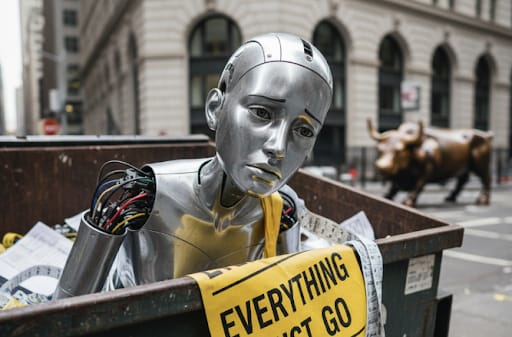- Live Life Grow Wealth
- Posts
- 🌐 Series 9 Day 3: Central Banks & Monetary Policy — The Real Market Movers
🌐 Series 9 Day 3: Central Banks & Monetary Policy — The Real Market Movers

Today’s Headline
🌐 Series 9: Global Investing & Economic Forces
Day 3: Central Banks & Monetary Policy — The Real Market Movers
Why a Handful of People Decide the Direction of Your Investments
When I first started investing, I used to wonder why markets would suddenly rise or fall even when nothing “big” seemed to be happening.
Then I realised something important: the biggest market moves are often caused by central banks, not companies.
Central banks are like the “invisible puppeteers” of the financial world.
When they pull a string, the entire stock market reacts.
When they change their tone, currencies jump.
When they speak in a certain way, trillions of dollars shift within minutes.
Today, I want to walk you through what central banks do, how monetary policy works, and why you must understand them if you want to grow your wealth confidently.
Trust me, once you understand the power these institutions hold, investing will feel less like guessing and more like reading a story that makes perfect sense.
“If You Enjoy My Daily Investing Insights, Click Here — I Found an Investment Tool You Don’t Want to Miss.”
$57 Billion in NVDA Revenue, 62% YoY Growth. And stocks still fell… What now?
Nvidia just posted a record-breaking quarter… yet the markets dropped. Why?
Experts say that even the top AI earnings couldn’t calm the fear of a potential bubble.
After soaring at the open, the S&P reversed sharply, wiping out over $2T of value in hours.
The “Great Bitcoin Crash of 2025” only wiped out ~$1T by comparison.
Wall Street’s finally asking: What if AI isn’t enough?
So, where can investors diversify when public markets stop making sense?
Now, for members-only → blue-chip art.
It’s not just for billionaires to tie the room together. It’s poised to rebound.
With Masterworks, +70k are investing in shares of multimillion dollar artworks featuring legends like Basquiat and Banksy.
And they’re not just buying. They’re selling too. Masterworks has exited 25 investments so far, including two this month, yielding net annualized returns like 14.6%, 17.6%, and 17.8%.*
My subscribers skip the waitlist:
*Past performance is not indicative of future returns. Investing involves risk. Reg A disclosures: masterworks.com/cd
🎯 What Is a Central Bank?
Think of a central bank as the “guardian” of a country’s money.
Every major country has one:
US → Federal Reserve
Europe → European Central Bank
UK → Bank of England
Japan → Bank of Japan
China → People’s Bank of China
Their job is simple in theory but massive in reality:
👉 Keep the economy stable.
A stable economy means:
People can work
Prices don’t go crazy
Businesses can grow
The currency stays strong
The financial system runs smoothly
But here’s what most people don’t realise:
Central banks control the flow of money.
And the flow of money controls everything else.
💸 How Central Banks Move Markets: The Two Big Tools
Central banks mainly use two huge “weapons” to influence the economy:
1️⃣ Interest rates
2️⃣ Money supply (also called monetary policy)
These two tools can decide whether:
Stocks rise or fall
Borrowing becomes cheap or expensive
Currencies strengthen or weaken
The economy grows or slows
Let me break them down in a way that’s easy for anyone to understand.
🔧 Tool #1: Interest Rates — The Price of Money
Interest rates are the cost of borrowing money.
When rates go down:
Loans become cheaper
Businesses borrow more
People buy houses, cars, and more things
Spending increases
Stock markets usually climb
When rates go up:
Borrowing becomes expensive
Companies slow down expansion
People cut spending
Economies cool
Stock markets often fall
Interest rates are like the “thermostat” of the economy.
If things get too hot → raise rates.
If things get too cold → lower rates.
🔧 Tool #2: Monetary Policy — Printing or Removing Money
Monetary policy simply means controlling the amount of money in the system.
When the central bank wants to stimulate the economy, it might:
Add more money
Buy government bonds
Lower borrowing costs
This gives businesses and people more “fuel” to spend.
When they want to cool things down, they might:
Reduce money supply
Sell bonds
Increase borrowing costs
This pulls money out of the system and slows everything down.
To make it simple, think of money like water:
More water = easy to grow
Less water = plants struggle
Central banks control the hose.
🧠 Why Central Banks Are the Real Market Movers
It doesn’t matter how strong a company is.
It doesn’t matter how fast an industry grows.
If the central bank tightens money, everything slows.
If the central bank loosens money, everything expands.
This is why you often hear people say:
“Don’t fight the Fed.”
It means:
👉 If the Federal Reserve is tightening, don’t assume markets will rise.
👉 If the Federal Reserve is easing, don’t bet against a bull market.
As an investor, understanding this can save you from big losses and help you catch big opportunities.
“Love My Market Updates? Click Here — This Investing Resource Could Level Up Your Portfolio Fast.”
Get Real Estate Training from Wharton Experts
Gain the skills top firms demand with the Wharton Online + Wall Street Prep Real Estate Investing & Analysis Certificate.
In 8 weeks, learn from leaders at Blackstone, KKR, Ares, and more while analyzing real deals.
Join 5,000+ graduates. Save $300 with code SAVE300.
🔥 How Central Banks Affect Different Markets
Let me walk you through how their decisions ripple through major markets.
📈 1. Stock Markets
When interest rates drop:
Borrowing becomes cheaper
Companies grow faster
Investors feel confident
Stock prices rise
When interest rates rise:
Companies struggle with higher costs
Growth slows
Investors panic
Stock markets fall
This is why tech stocks often fall the moment interest rates go up—they rely heavily on future earnings and cheap borrowing.
💵 2. Currency Markets
Currencies move based on interest rate differences between countries.
Higher interest rates → currency strengthens
Lower interest rates → currency weakens
This happens because investors chase higher returns.
So if the US raises interest rates, the US dollar usually gets stronger.
If Japan cuts rates deeper, the yen weakens.
🏦 3. Bond Markets
Bonds are extremely sensitive to central bank decisions.
When interest rates rise:
Bond prices fall
Yields rise
When rates drop:
Bond prices rise
Yields fall
Bond investors watch central banks like hawks because even tiny rate changes can shift billions of dollars.
🛢️ 4. Commodities (Gold, Oil, etc.)
Commodities also move based on central bank policy.
Lower rates → weaker currency → gold often rises
Higher rates → stronger currency → gold falls
Oil responds more to global demand, but rates still influence the overall economic momentum.
🌪️ The Power of Words: Why Central Bank Speeches Move Markets
Here’s something funny but true:
Sometimes central banks don’t even need to do anything.
Just speaking can move markets.
One sentence from a central banker can cause:
Stock markets to jump
Bond yields to swing
Currencies to spike
Gold to rise
Why?
Because investors react to expectations, not just actions.
If a central bank hints that rates might rise soon, the market reacts immediately, even before the change happens.
🎙️ “Forward Guidance” — The Secret Weapon
Central banks often give hints about what they plan to do in the future.
This is called forward guidance.
For example:
“We will keep interest rates low for longer.”
“We are prepared to act if inflation remains high.”
“The economy is showing signs of overheating.”
These hints help investors prepare for future moves.
As an investor, I always pay attention to:
Tone of the speech
Words they repeat
Words they avoid
Whether they sound more confident or worried
The market listens to every word as if it’s gold.
“If You Enjoy My Investing Tips, Click Here — This Could Be Your Next Big Advantage.”
Run ads IRL with AdQuick
With AdQuick, you can now easily plan, deploy and measure campaigns just as easily as digital ads, making them a no-brainer to add to your team’s toolbox.
You can learn more at www.AdQuick.com
🧩 Why Monetary Policy Matters More Than Company Performance
A company can have strong earnings…
But if the central bank raises interest rates suddenly, its stock may still fall.
This is why I always remind my subscribers:
👉 Macro beats micro.
It means the big picture (central banks + economy) has more influence than the small picture (individual companies).
When central banks tighten, even great companies struggle.
When central banks ease, even weak companies can rise.
This is why understanding monetary policy is one of the most powerful investing skills you can learn.
🧭 How I Use Central Bank Signals in My Investing Strategy
Let me share how I personally use central bank news to guide my investments.
⭐ When central banks are easing (lowering rates / adding money):
I tend to:
Buy growth stocks
Increase equity exposure
Add tech and innovation names
Expect stronger bull markets
Take more calculated risks
Money becomes cheaper.
Markets rise easier.
It’s a good environment for investors.
⭐ When central banks are tightening (raising rates / reducing money):
I tend to:
Reduce high-risk stocks
Move some funds to defensive sectors
Hold more cash
Be patient with entries
Expect more volatility
This is where many investors get hurt.
They try to fight the tightening cycle.
But tighter money almost always slows markets.
⭐ When central banks are neutral:
I focus on fundamentals:
Company earnings
Valuations
Long-term growth themes
Sector rotation
This is usually a stable period with fewer surprises.
🧠 Easy Ways You Can Track Monetary Policy Without Being an Economist
You don’t need to analyze long reports.
Here are simple signs you can watch:
✔️ Inflation rising fast
Central banks may raise rates.
✔️ Economy slowing
They may cut rates to support growth.
✔️ Job market too strong
Rates may go up to cool things down.
✔️ Currency weakening too much
Rates may rise to protect it.
✔️ Market panicking
They may add liquidity to calm markets.
Just watching these patterns can make you a smarter investor.
🔥 Real-World Examples That Show Central Bank Power
Here are a few simple stories that show the impact of monetary policy.
📘 Example 1: When Rates Hit Zero
When interest rates were cut to near zero, money flooded the system.
Stocks soared
Tech exploded
Borrowing surged
House prices jumped
This was a classic example of easy monetary policy fueling a bull market.
📘 Example 2: When Rates Went Up Fast
As inflation shot up, central banks raised rates quickly.
Borrowing became expensive
Consumers reduced spending
Tech stocks crashed
Recession fears rose
This was a clear sign of tight monetary policy cooling the market.
📘 Example 3: When Central Banks Only Spoke
Sometimes even without raising or cutting rates, central banks caused big moves simply by changing their tone.
For example:
A single sentence about “future inflation concerns” can sink markets.
A word like “patience” can calm markets.
It shows how psychological monetary policy can be.
🎯 The Main Lesson: Central Banks Decide the Market Environment
You can pick the best company in the world.
You can choose the fastest-growing industry.
You can time your entry perfectly.
But if the central bank tightens money, you will still struggle.
On the other hand, even if you enter a stock late, a loose monetary policy can help you win.
The environment matters even more than the stock.
📌 Key Takeaways (Simple & Powerful)
Let me summarize everything in simple points:
Central banks control money flow
They use interest rates and monetary policy
Their decisions create bull or bear markets
Stock markets love low rates
Stock markets fear high rates
Their speeches alone can move markets
Macro direction is more important than individual stock picks
Understanding monetary policy makes you a wiser, calmer investor
If you understand this, you’re already ahead of most investors.
Final Takeaways
Whenever you feel confused about the market, don’t start with the stock.
Start with the environment.
Ask yourself:
Is the central bank easing or tightening?
Are rates going up or down?
Is inflation rising or falling?
Is the economy speeding up or slowing down?
These questions can guide almost every investment decision you make.
And the best part?
You don’t need complex charts or formulas.
Just the ability to observe.
🚀 Your Call to Action
Today, I want you to build a simple habit:
👉 Pick one major central bank and check whether they are tightening or easing right now.
Write it down.
Think about how it affects your portfolio.
See if it matches what the markets are doing.
This one small habit will sharpen your investment instincts faster than anything else.
[Live Life Grow Wealth]
🎓 Free Masterclasses to Unlock Your Investment Potential
Take your money skills to the next level with expert-led workshops designed to help you grow smarter and faster.
Recommendations Section
“Peek into smart money moves — when big players act, you’re in the loop.”
|
Learn simple, proven ways to grow your money — straight from real investors who walk the talk.
|
“Hone your investing edge in just 5 minutes — smart, snappy insights to power your portfolio growth.”
|
“Stay ahead with one expert-picked stock weekly — clear, no jargon, built for growth.”
|
DISCLAIMER
I make no representations, warranties, or guarantees, whether expressed or implied, that the content provided is accurate, complete, or up-to-date. Past performance is not indicative nor a guarantee of future returns.
I am an individual content creator and not regulated or licensed by the Monetary Authority of Singapore (MAS) as I do not provide investment services.
All forms of investments carry risks, including the risk of losing your entire invested amount. Such activities may not be suitable for everyone. You are strongly encouraged to seek advice from a professional financial advisor if you have any doubts or concerns.










